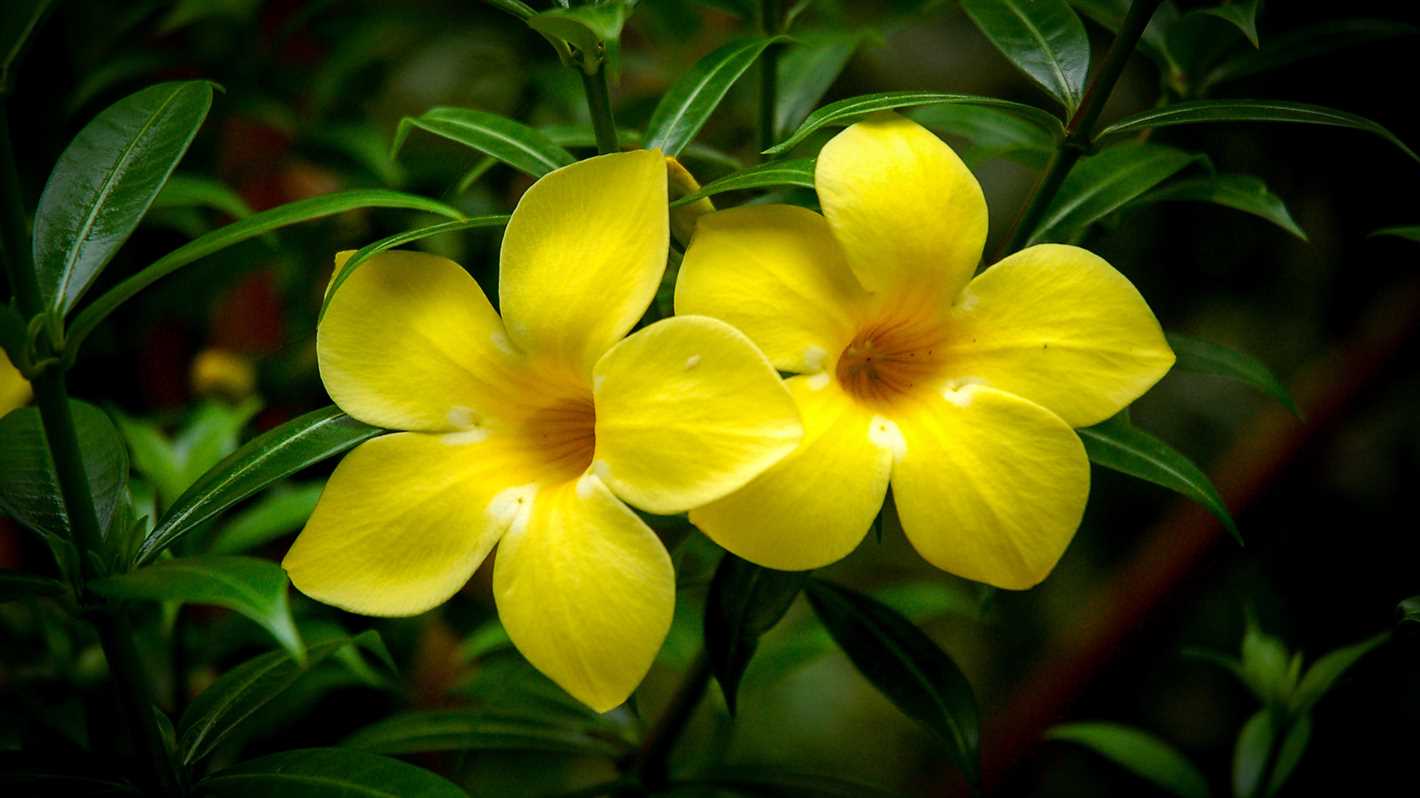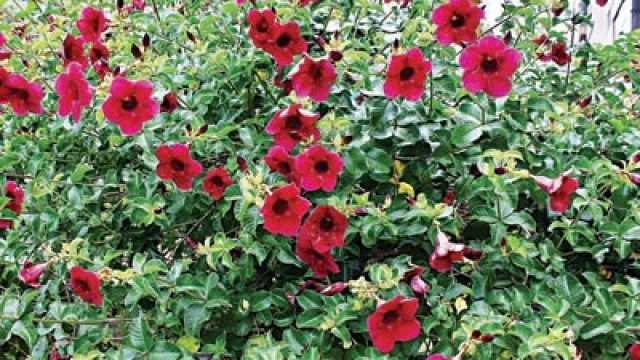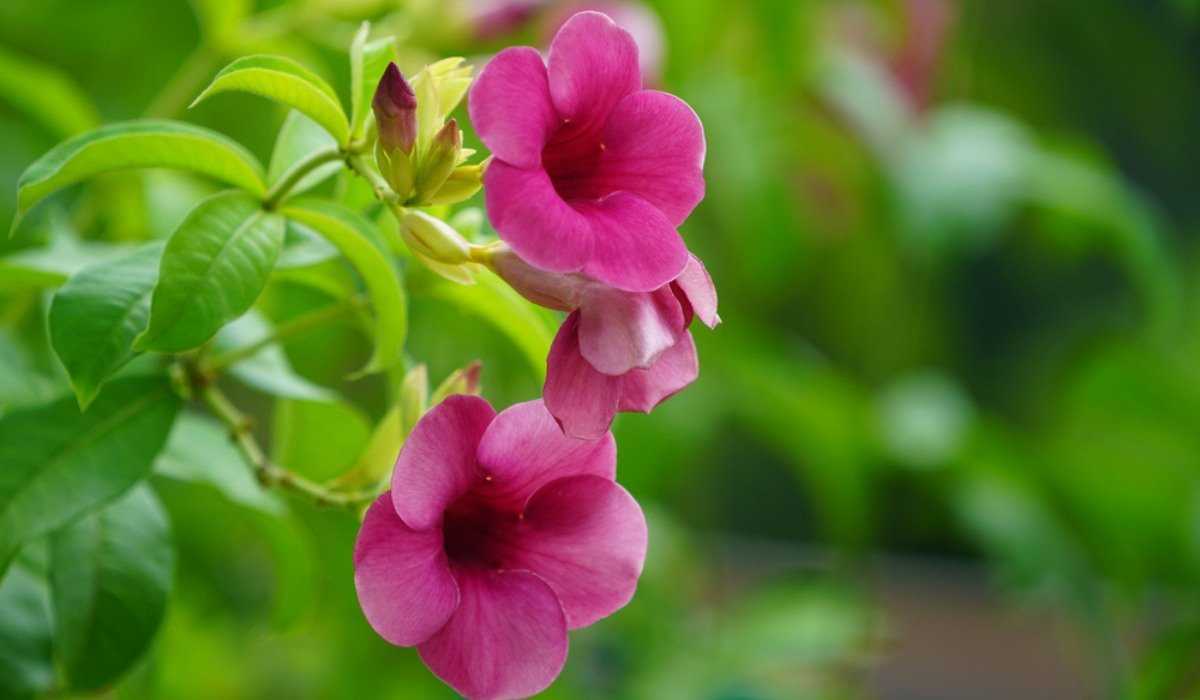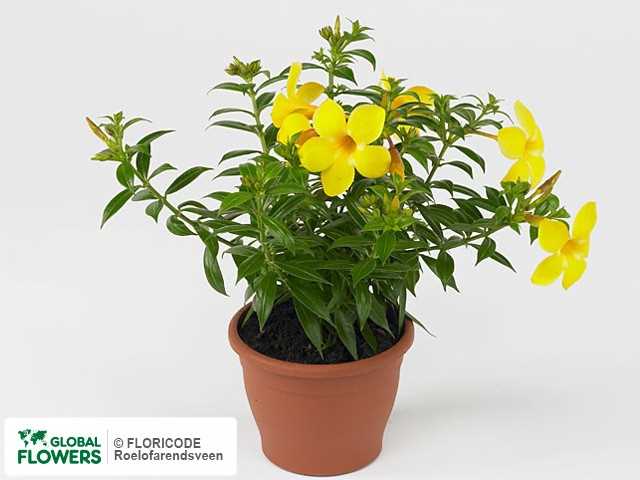- Allamanda Photos: Visual Delight of Various Species
- Allamanda Yellow: The Most Popular Species
- Allamanda Cathartica: A Lush Tropical Vine
- Appearance
- Care and Cultivation
- Uses and Benefits
- Allamanda Cherries: Ravishing Red Blooms
- Characteristics of Allamanda Cherries
- Growing and Caring for Allamanda Cherries
- Uses of Allamanda Cherries
- Allamanda Blanche: A Charming White Variety
- Allamanda Schottii: Exotic Species from South America
- Allamanda Purple: The Rare and Vibrant Blossom
- Appearance
- Environmental Requirements
- Care and Maintenance
- Uniqueness and Rarity
- In Conclusion
- Q&A:
- What is allamanda?
- How do I care for allamanda?
- Can allamanda be grown indoors?
- What are some common species of allamanda?
- How do I propagate allamanda?
- Are allamanda plants toxic to pets?
- Video: Grow allamanda flower vine with cutting best growing tips in rainy season must watch
The allamanda is a stunning flowering plant that is native to tropical regions. With its vibrant yellow flowers and glossy green leaves, it is a popular choice for gardens and indoor spaces. In this complete guide, we will explore everything you need to know about caring for allamanda plants, as well as showcase some beautiful photos and discuss different species.
Caring for an allamanda plant requires attention to its specific needs. It thrives in bright, indirect sunlight and well-draining soil. Regular watering is necessary, especially during the growing season, but be careful not to overwater as this can lead to root rot. Pruning is also important to maintain the plant’s shape and encourage new growth.
Allamanda plants belong to the Apocynaceae family and there are several species within this genus. The most common species is the Allamanda cathartica, which is known for its large, trumpet-shaped flowers. There are also variations with different flower colors, such as the Allamanda blanchetii with its purple flowers and the Allamanda schottii with its orange-yellow blooms.
Whether you are a new plant parent or an experienced gardener, this complete guide to allamanda plants will provide you with the knowledge and inspiration you need to successfully care for and enjoy these beautiful plants. Explore the photos to see the stunning variety of allamanda flowers and learn about the different species that you can choose from for your own garden or indoor space.
Allamanda Photos: Visual Delight of Various Species
The Allamanda plant is known for its beautiful and vibrant flowers. Here are some photos showcasing the different species of Allamanda:
Allamanda cathartica
This species of Allamanda has large yellow flowers with a trumpet shape. The bright yellow color is a visual delight and adds a pop of color to any garden.

Allamanda blanchetii
Allamanda blanchetii has delicate purple flowers with a yellow throat. The combination of purple and yellow creates a stunning contrast and makes this species a standout in any garden.

Allamanda schottii
This species of Allamanda has large white flowers with a yellow center. The white blooms are elegant and add a touch of sophistication to any landscape.

These are just a few examples of the beautiful Allamanda species. Each species has its own unique charm and can be a visual delight in any garden or landscape.
Allamanda Yellow: The Most Popular Species

The Allamanda yellow is one of the most popular species among Allamanda plants. This species is known for its vibrant and eye-catching yellow flowers that bloom in clusters.
Origin: The Allamanda yellow is native to South and Central America, specifically in countries such as Brazil, Guyana, and Venezuela.
Appearance: The Allamanda yellow is a climbing vine with glossy, dark green leaves. The flowers are trumpet-shaped and can measure up to 4-5 inches in diameter. The bright yellow color of the flowers adds a pop of color to any garden or indoor space.
Care: The Allamanda yellow requires bright, indirect sunlight to thrive. It is a tropical plant that prefers warm temperatures between 70-90°F (21-32°C). It needs well-draining soil and regular watering, allowing the top inch of soil to dry out between waterings. Fertilize the plant once a month during the growing season to promote healthy growth and blooming.
Propagation: The Allamanda yellow can be propagated through stem cuttings. Take a cutting of about 6-8 inches in length from the mother plant, making sure it has at least two leaf nodes. Remove the lower leaves and place the cutting in a pot with moist soil. Keep the soil consistently moist until roots form, which usually takes about 4-6 weeks.
Common problems: The Allamanda yellow is generally a low-maintenance plant, but it can be susceptible to pests such as aphids and mealybugs. Regularly inspect the plant for any signs of pest infestation and treat them accordingly with organic insecticides or soapy water. Overwatering can also lead to root rot, so make sure to provide proper drainage and avoid waterlogging.
| Common Name | Scientific Name | Origin | Flower Color |
|---|---|---|---|
| Allamanda Yellow | Allamanda cathartica | South and Central America | Yellow |
Allamanda Cathartica: A Lush Tropical Vine
Allamanda Cathartica, commonly known as Golden Trumpet, is a species of flowering plant in the family Apocynaceae. This lush tropical vine is native to Brazil, but it can also be found in other parts of South America. It is widely cultivated and prized for its large, showy flowers and glossy green foliage.
Appearance
Allamanda Cathartica is a fast-growing perennial vine that can reach heights of up to 20 feet or more. Its leaves are dark green, leathery, and oblong in shape. The vine produces large, trumpet-shaped flowers that are typically golden yellow in color, although there are cultivars with variations in shades of yellow and orange. Each flower can reach 3 to 5 inches in diameter and has a waxy texture.
Care and Cultivation

Allamanda Cathartica requires a warm, tropical climate and full sun to thrive. It prefers well-draining soil and moderate watering. The vine should be regularly pruned to control its growth and promote bushier growth. It is important to note that all parts of the plant are toxic if ingested, so it should be kept away from curious pets and children.
- Plant the vine in a location that receives at least 6 hours of direct sunlight.
- Water the plant regularly, keeping the soil evenly moist but not waterlogged.
- Fertilize the vine every 2 to 4 weeks during the growing season with a balanced fertilizer.
- Prune the vine in late winter or early spring to control its size and shape.
- Protect the vine from frost and cold temperatures, as it is sensitive to cold.
Uses and Benefits

Allamanda Cathartica is primarily grown for ornamental purposes due to its stunning flowers and foliage. It is commonly used as a climbing or trailing vine in gardens, along fences, and on trellises. Its vibrant flowers attract pollinators, such as butterflies and bees, making it a great addition to wildlife gardens. In some traditional medicine practices, the plant’s leaves and sap have been used to treat various ailments, though caution should be exercised as it is toxic if ingested.
Allamanda Cherries: Ravishing Red Blooms
The Allamanda plant is known for its beautiful and vibrant blooms. One variety of Allamanda that stands out is the Allamanda Cherries. With its ravishing red blooms, it is sure to catch anyone’s attention.
Characteristics of Allamanda Cherries
- Allamanda Cherries is a climbing vine that can reach up to 10 feet in height.
- The leaves of the Allamanda Cherries are glossy and dark green, providing a nice contrast to the bright red flowers.
- The flowers of the Allamanda Cherries are trumpet-shaped with five petals. They have a deep red color and bloom in clusters.
- The blooms of Allamanda Cherries are fragrant, filling the air with a pleasant scent.
- This variety of Allamanda is a tropical plant and thrives in warm climates.
Growing and Caring for Allamanda Cherries
To ensure the optimal growth and health of your Allamanda Cherries, here are some care tips:
- Light: Allamanda Cherries require full sun to thrive. Place the plant in a location where it can receive at least 6 hours of direct sunlight per day.
- Water: The Allamanda Cherries prefers a consistently moist soil. Water the plant regularly, ensuring that the soil does not dry out completely.
- Soil: Allamanda Cherries prefers a well-drained soil with a slightly acidic pH. You can add organic matter, such as compost, to improve soil fertility.
- Fertilizer: Use a balanced fertilizer formulated for flowering plants. Apply it according to the manufacturer’s instructions during the growing season to promote healthy growth and abundant blooms.
- Pruning: Prune the Allamanda Cherries in late winter or early spring to control its size and shape. Remove any dead or damaged branches to encourage new growth.
Uses of Allamanda Cherries
Allamanda Cherries can be used in various ways to enhance your garden or landscape:
- Plant the Allamanda Cherries near a trellis or arbor to create a beautiful vertical accent.
- Use the Allamanda Cherries as a colorful ground cover in areas with full sun.
- Plant the Allamanda Cherries in containers and place them on your patio or deck to add a pop of color.
- Combine the Allamanda Cherries with other flowering plants to create a vibrant and eye-catching flower bed.
| Scientific Name | Allamanda Cherries |
|---|---|
| Family | Apocynaceae |
| Native to | South America |
| Blooming Season | Spring to fall |
Allamanda Blanche: A Charming White Variety
Allamanda Blanche is a beautiful variety of the Allamanda plant, known for its stunning white flowers. It is a tropical plant native to South America and belongs to the Apocynaceae family. The name ‘Blanche’ refers to the French word for white, which perfectly describes the color of its flowers.
This variety of Allamanda is highly sought after by garden enthusiasts due to its unique white blooms. The flowers are large, trumpet-shaped, and have a delightful fragrance. They have five petals that open up to reveal a yellow throat, which adds a beautiful contrast to the white color.
- Care and Maintenance:
Growing Allamanda Blanche requires proper care and maintenance to ensure its healthy growth and blooming. Here are some key points to consider:
- Light: Allamanda Blanche thrives in bright, indirect sunlight. It should be placed in a location where it can receive at least 4-6 hours of sunlight each day.
- Watering: The plant should be watered thoroughly, allowing the soil to dry out slightly between waterings. Overwatering can lead to root rot, so it’s important to maintain a well-draining soil.
- Temperature: Allamanda Blanche prefers warm temperatures above 60°F (15°C). It is not cold-hardy and should be protected from frost or extreme cold.
- Pruning: Regular pruning helps maintain the shape of the plant and encourages new growth. Cut back any dead or damaged branches and trim the plant after flowering to promote bushiness.
- Fertilizer: Feed the plant with a balanced fertilizer once a month during the growing season (spring and summer). This will provide the necessary nutrients for healthy growth and blooming.
Allamanda Blanche can be grown both outdoors and indoors, depending on the climate. It is often used in landscapes, gardens, and as a container plant. It adds a touch of elegance and beauty with its white flowers and glossy green leaves.
| Common Name | Allamanda Blanche |
|---|---|
| Botanical Name | Allamanda spp. |
| Family | Apocynaceae |
| Origin | South America |
| Flower Color | White with yellow throat |
| Sun Exposure | Bright, indirect sunlight |
| Watering | Thoroughly, allowing soil to dry out slightly |
| Temperature | Above 60°F (15°C) |
With its charming white flowers and lush green foliage, Allamanda Blanche is a wonderful addition to any garden or indoor space. Its easy care requirements make it suitable for both beginner and experienced gardeners. If you’re looking for a unique and elegant plant, Allamanda Blanche is an excellent choice.
Allamanda Schottii: Exotic Species from South America

Allamanda Schottii, also known as yellow bell, is a stunning and exotic species of flowering plant native to South America. It belongs to the Apocynaceae family and is highly admired for its vibrant yellow flowers.
Appearance
Allamanda Schottii is a woody vine that can climb up to 15 feet. It has simple, elliptic leaves that are bright green and glossy. The flowers are trumpet-shaped, measuring about 3-5 inches in length, and have a distinctive lemon yellow color. They bloom profusely during the warm months, creating a striking display in any garden or landscape.
Care
Allamanda Schottii thrives best in tropical and subtropical climates. It requires full sun exposure to blossom properly. Adequate watering is essential, as the plant prefers moist but well-draining soil. It is recommended to fertilize the plant regularly during the growing season for optimal growth and flowering.
Pruning is necessary to maintain a tidy appearance and control growth. It is also important to note that all parts of the Allamanda are toxic if ingested, so keep it away from children and pets.
Propagation
Propagating Allamanda Schottii can be done through stem cuttings. Take cuttings from the plant during the spring or early summer, and ensure they have at least two nodes. Remove the lower leaves and place the cuttings in a well-draining potting mixture. Keep them warm and provide adequate moisture until roots start to form.
Common Varieties
- Allamanda cathartica: Also known as golden trumpet, it features bright yellow flowers and is the most widely cultivated species of Allamanda.
- Allamanda hendersonii: This species has pale yellow flowers and is native to Jamaica.
- Allamanda blanchetii: It has purple flowers and is commonly called the purple Allamanda.
Conclusion
Allamanda Schottii is a mesmerizing species of flowering plant that adds a tropical touch to any garden. With its showy yellow flowers and glossy foliage, it is sure to attract attention and admiration. However, it is important to handle the plant with care due to its toxicity. Overall, Allamanda Schottii is an excellent choice for those seeking a striking and exotic addition to their plant collection.
Allamanda Purple: The Rare and Vibrant Blossom
Allamanda Purple is a rare and vibrant flowering plant that belongs to the Allamanda genus. It is known for its stunning purple blossoms that add a pop of color to any garden or landscape. If you are looking for a unique and eye-catching plant to enhance your garden, Allamanda Purple is a perfect choice.
Appearance
The Allamanda Purple plant features large, trumpet-shaped flowers that can reach up to 4 inches in diameter. The vibrant purple color of the blossoms is unlike any other, making it a standout among other flowering plants. The flowers have a mild fragrance, adding to the overall sensory experience of having Allamanda Purple in your garden.
Environmental Requirements
Allamanda Purple thrives in warm and tropical climates, making it a popular choice for gardens in places like Florida and the Caribbean. It requires full sun exposure to grow and bloom properly. It is also important to provide well-draining soil for this plant, as it does not tolerate standing water. Regular watering is necessary to keep the plant healthy and hydrated.
Care and Maintenance
Taking care of Allamanda Purple is relatively easy. Regular pruning is recommended to maintain its shape and promote healthy growth. It is important to remove any dead or damaged branches to prevent disease and pests. Fertilizing the plant with a balanced fertilizer during the growing season will help keep it healthy and blooming.
It is worth noting that Allamanda Purple is toxic if ingested, so caution should be exercised if there are children or pets in the vicinity. It is advisable to wear gloves while handling the plant to avoid any potential skin irritation.
Uniqueness and Rarity
Allamanda Purple is considered a rare plant, mainly due to its vibrant purple color. While other species of Allamanda are more commonly found, the purple variety is more challenging to come across. Its uniqueness and rarity make it a highly sought-after plant among collectors and gardening enthusiasts.
In Conclusion
Allamanda Purple is a rare and vibrant flowering plant that stands out with its stunning purple blossoms. It is relatively easy to care for and provides a unique addition to any garden or landscape. If you are looking for a plant that will make a statement and add a touch of rarity to your outdoor space, Allamanda Purple is an excellent choice.
Q&A:
What is allamanda?
Allamanda is a genus of flowering plants in the dogbane family, Apocynaceae. They are native to tropical regions of the Americas.
How do I care for allamanda?
Allamanda plants require full sun and well-drained soil. They should be watered regularly, especially during the growing season, and fertilized once a month with a balanced fertilizer. Pruning is needed to maintain their shape and remove dead or diseased parts. It is also important to provide support for climbing varieties.
Can allamanda be grown indoors?
Allamanda can be grown indoors but it requires a lot of sunlight. Place the plant in a sunny window or use artificial grow lights to provide sufficient light. It is recommended to keep the plant outdoors during the warmer months to promote healthy growth.
What are some common species of allamanda?
Some common species of allamanda include Allamanda cathartica, Allamanda neriifolia, and Allamanda blanchetii. Allamanda cathartica is the most commonly cultivated species and is known for its large yellow flowers.
How do I propagate allamanda?
Allamanda can be propagated through stem cuttings. Take a 4 to 6-inch cutting from a healthy plant, remove the lower leaves, and dip the cut end in a rooting hormone. Plant the cutting in a pot with well-draining soil and keep it moist until roots develop. It is best to propagate allamanda in the spring or early summer.
Are allamanda plants toxic to pets?
Yes, allamanda plants are toxic to pets, particularly cats and dogs. They contain toxic substances that can cause vomiting, nausea, and other symptoms if ingested. It is important to keep pets away from these plants and seek immediate veterinary attention if poisoning is suspected.
Video:
Grow allamanda flower vine with cutting best growing tips in rainy season must watch










